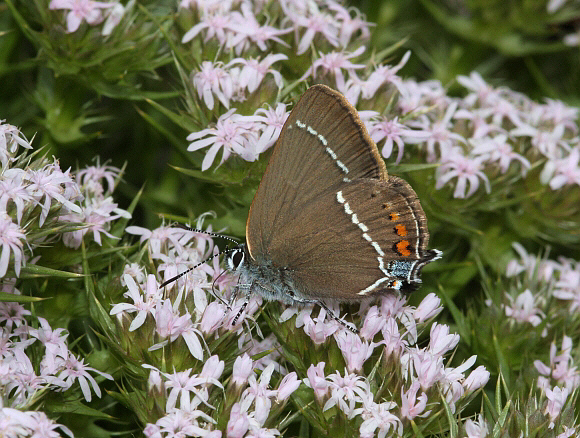 Blue-spot Hairstreak Satyrium spini, Velebit Mts, Croatia – Peter Bruce-Jones
Blue-spot Hairstreak Satyrium spini, Velebit Mts, Croatia – Peter Bruce-Jones
Introduction
There are 64 described species in the genus Satyrium, which has at various times been known by the invalid synonyms Neolycaena, Nordmannia, Pseudothecla and Strymonidia. The genus occurs across the temperate, sub-arctic and subtropical regions of the northern hemisphere.
There are 7 species in Europe – acaciae, ilicis, esculi, spini, w-album, pruni and ledereri; of which only w-album and pruni occur in Britain.
Satyrium spini is found in Portugal, Spain, France, Italy, Switzerland, Austria, Germany, Poland, Hungary, Croatia, Greece, Turkey, and east to Iraq and Iran.
Habitats
This species is found mainly in hot, dry, scrubby habitats including woodland clearings, grassland, lightly wooded mountainsides and bushy meadows; typically at altitudes between sea level and about 1500m, although colonies occur as high as 2000m in Greece.
Lifecycle
The Blue-spot Hairstreak is single-brooded, flying from late May to early August depending on locality and altitude.
The eggs are usually laid in groups of between 3-5 on woody twigs of the foodplants, usually close to a fork. They are a dirty whitish colour with a prominent micropyle, and are covered in a fine network polygonal depressions. The caterpillars are fully formed within the eggs shortly after they are laid in the summer, but do not hatch until the following March.
The caterpillar is woodlouse-shaped but with well defined segments. It is green, slightly hairy, and marked along the back with a pair of broken cream stripes. There are a series of forward-slanting suffused creamy diagonal bars along the sides, and a solid cream line below the spiracles. If feeds on Rhamnus ( buckthorn ), usually resting on the underside of the stems or leaves. In common with most other Lycaenidae species the larvae are tended by ants which “milk” them to obtain sugary substances secreted from their dorsal gland.
The chrysalis is attached by a fine silken girdle to the underside, or occasionally to the upperside, of a living leaf of the foodplant. It is pale brown, heavily speckled. It is plump in form, rounded at the head and tail, and covered in short bristly hairs.
Adult behaviour
The adults can easily be overlooked due to their reclusive and sedentary nature, and are normally only seen in two’s or three’s, although occasionally colonies of 100 or more can be found.
Both sexes nectar at the flowers of a wide variety of herbaceous plants including wood spurge, yarrow, lavender, stonecrop and thyme. They also visit the flowers of bramble bushes
